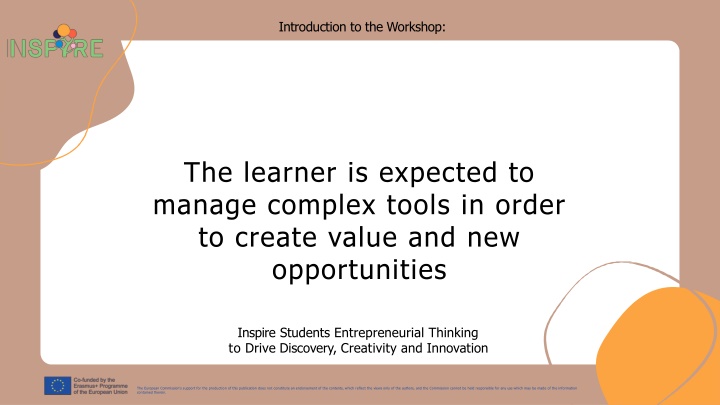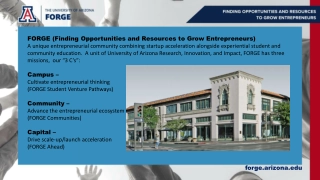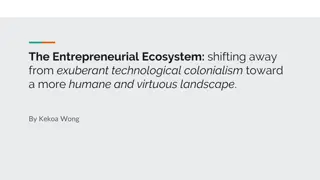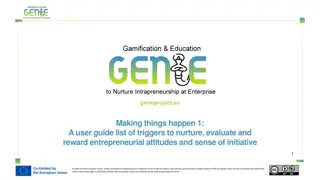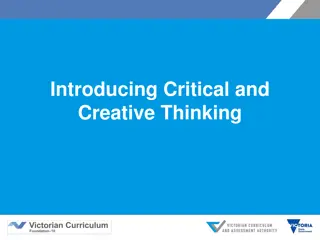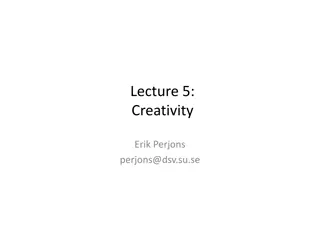Inspire Entrepreneurial Thinking for Value Creation
This workshop focuses on equipping learners with the ability to manage complex tools, fostering entrepreneurial thinking to drive discovery, creativity, and innovation. Participants will delve into activities such as creating empathy maps to understand customer needs and perspectives. The outcomes aim to match analysis tools with business plans and identify new possibilities. Through practical exercises and discussions, attendees will enhance their skills in uncovering opportunities and generating value.
Download Presentation

Please find below an Image/Link to download the presentation.
The content on the website is provided AS IS for your information and personal use only. It may not be sold, licensed, or shared on other websites without obtaining consent from the author.If you encounter any issues during the download, it is possible that the publisher has removed the file from their server.
You are allowed to download the files provided on this website for personal or commercial use, subject to the condition that they are used lawfully. All files are the property of their respective owners.
The content on the website is provided AS IS for your information and personal use only. It may not be sold, licensed, or shared on other websites without obtaining consent from the author.
E N D
Presentation Transcript
Introduction to the Workshop: The learner is expected to manage complex tools in order to create value and new opportunities Inspire Students Entrepreneurial Thinking to Drive Discovery, Creativity and Innovation The European Commission's support for the production of this publication does not constitute an endorsement of the contents, which reflect the views only of the authors, and the Commission cannot be held responsible for any use which may be made of the information contained therein.
The learner is expected to manage complex tools in order to create value and new opportunities Learning Outcomes to be Covered - match the needs analysis tools to your business plan - develop the analysis methodology in order to identify new possibilities The European Commission's support for the production of this publication does not constitute an endorsement of the contents, which reflect the views only of the authors, and the Commission cannot be held responsible for any use which may be made of the information contained therein.
The learner is expected to manage complex tools in order to create value and new opportunities This workshop covers 3 activities. The first activity Short involves defining a customer segment for an empathy map. Later, the stages of an empathy map Introduction will be discussed. At the end of the workshop, participants will be required to prepare an exemplary empathy map and discuss it. The European Commission's support for the production of this publication does not constitute an endorsement of the contents, which reflect the views only of the authors, and the Commission cannot be held responsible for any use which may be made of the information contained therein.
The learner is expected to manage complex tools in order to create value and new opportunities Empathy map - a tool for researching customer needs Empathy for the perception of the mental states of other people (emotional empathy) and the visual-minded way of thinking, looking at their perspectives from their perspective. Empathetic people are aware of the feelings of others, see the basis of their values and are able to empathize with specific conditions. Such behavior allows for the verification of views and may allow the authorship to make mistakes. Lack of empathy in the context of actions related to a negative, negative fact leads to indifference and difficulties in solving problems. The European Commission's support for the production of this publication does not constitute an endorsement of the contents, which reflect the views only of the authors, and the Commission cannot be held responsible for any use which may be made of the information contained therein.
The learner is expected to manage complex tools in order to create value and new opportunities Developing a map of empathy Determining in which business area and for which customer group we want to develop a product, service or improvement. Ask a question: What do you want to do - what to produce or sell? Which clients do you want to work with, for whom to create some value - new solutions, products, services? Who creates the potentially largest group of consumers in your area of interest? The European Commission's support for the production of this publication does not constitute an endorsement of the contents, which reflect the views only of the authors, and the Commission cannot be held responsible for any use which may be made of the information contained therein.
The learner is expected to manage complex tools in order to create value and new opportunities Customer segment identification effect Good segmentation of a group of potential customers will help you find your own niche or something that will distinguish your offer from the competition. By directing the product to a specific group of buyers, we can better adapt it to the requirements and it is easier to develop an action plan on the market. This approach also helps minimize business risk, because having a description of a specific customer segment it is easier to imagine what problems they may encounter. The European Commission's support for the production of this publication does not constitute an endorsement of the contents, which reflect the views only of the authors, and the Commission cannot be held responsible for any use which may be made of the information contained therein.
The learner is expected to manage complex tools in order to create value and new opportunities The map of empathy shows how to analyze the needs of customers and, based on their identified needs, create new The map of empathy values and opportunities, new solutions. When building an empathy map, one should always refer to one previously identified customer segment. When developing a map of empathy, the needs of clients should be taken into account, both in terms of professional and private life. The European Commission's support for the production of this publication does not constitute an endorsement of the contents, which reflect the views only of the authors, and the Commission cannot be held responsible for any use which may be made of the information contained therein.
The learner is expected to manage complex tools in order to create value and new opportunities Six main areas should be identified to build an empathy map: Stage I. Identifying the concerns, fears and sources of anxiety of clients In the first area, the problems encountered by clients at work, in their personal lives, in which situations they most often experience negative emotions, what unexpected costs or unpleasant situations occur to them in the process of finding a solution, assessing the quality and choosing a solution, and purchasing a solution should be identified. The European Commission's support for the production of this publication does not constitute an endorsement of the contents, which reflect the views only of the authors, and the Commission cannot be held responsible for any use which may be made of the information contained therein.
The learner is expected to manage complex tools in order to create value and new opportunities Six main areas should be identified to build an empathy map: Stage II. Benefits and aspirations The second step in creating an empathy map is to identify the positive elements - benefits - expected by potential customers when using the product or service. You should consider what kind of benefits do people from the customer segment you specify? What is the most important thing for them when choosing a product or service? What kind of positive emotions do they want to experience? What are their personal and professional desires and aspirations? The European Commission's support for the production of this publication does not constitute an endorsement of the contents, which reflect the views only of the authors, and the Commission cannot be held responsible for any use which may be made of the information contained therein.
The learner is expected to manage complex tools in order to create value and new opportunities Six main areas should be identified to build an empathy map: Stage III. Observations In the third area of empathy mapping, you need to consider what your clients' day-to-day environment looks like - both private and professional. Where do they live and work, in what environment do they live and with whom do they meet on a daily basis? What is boring for them and what do they not expect to see and what might intrigue them? On this basis, it is possible to consider what kind of offers customers usually receive and what information resources are they used to? The European Commission's support for the production of this publication does not constitute an endorsement of the contents, which reflect the views only of the authors, and the Commission cannot be held responsible for any use which may be made of the information contained therein.
The learner is expected to manage complex tools in order to create value and new opportunities Six main areas should be identified to build an empathy map: Stage IV. Opinions The next, very important step in creating an empathy map is identifying what opinions our potential client meets. The social environment in which we operate has a very large impact on our decisions about purchasing specific products or services. Both direct - we are looking for information from others, advice from professionals, and we are persuaded by relatives - partners, parents, children, friends, etc. Consider what opinions your client meets - both in the professional and personal area. What stereotypes does he encounter? What are the views of his professional community about various aspects of the job or about the suppliers of products or services? The European Commission's support for the production of this publication does not constitute an endorsement of the contents, which reflect the views only of the authors, and the Commission cannot be held responsible for any use which may be made of the information contained therein.
The learner is expected to manage complex tools in order to create value and new opportunities Six main areas should be identified to build an empathy map: Stage V. Thoughts and feelings In stage five, you should focus on the emotional realm and consider how your clients think and feel. Pay particular attention to the separation of thoughts from emotions (what the person thinks and how they feel about it). Emotions are one of the key factors influencing the decision to choose a product or service, so you should be particularly interested in positive emotions that you can arouse thanks to your offer and negative emotions that customers experience when using potential competitors' products or services. Also consider the emotional sphere of clients in general - what emotions are they experiencing, what are they missing, what would they like to experience more? The European Commission's support for the production of this publication does not constitute an endorsement of the contents, which reflect the views only of the authors, and the Commission cannot be held responsible for any use which may be made of the information contained therein.
The learner is expected to manage complex tools in order to create value and new opportunities Six main areas should be identified to build an empathy map: Stage VI. Beliefs and behaviors In the sixth step, it's important to think about what your clients believe and how they behave. From the point of view of developing a business idea, it is especially important to find situations in which customers think or say one thing and do something else. These are often situations of great mental discomfort that you can try to reduce with your product or solution. If you create a product or service that solves such a dilemma, your customers' interest is guaranteed. Look for discrepancies in both professional and private life. An example of a product that solved the problem of "I think one thing, I do another" is the electronic cigarette, which conquered the Polish market in practically a few months. Why? It helped smokers to overcome this discomfort: "I know cigarettes are unhealthy, but I still smoke them." The European Commission's support for the production of this publication does not constitute an endorsement of the contents, which reflect the views only of the authors, and the Commission cannot be held responsible for any use which may be made of the information contained therein.
The learner is expected to manage complex tools in order to create value and new opportunities Based on the previous analysis, the diagnosed customer needs that we are able to satisfy should be divided into 4 groups: 1. Functional needs: - Do your customers have any problem you can help solve? - Maybe they have a task to do that you can facilitate? Most of the services in the B2B (business to business) sector are located here. - Maybe you are able to speed up some processes that clients are already carrying out? The European Commission's support for the production of this publication does not constitute an endorsement of the contents, which reflect the views only of the authors, and the Commission cannot be held responsible for any use which may be made of the information contained therein.
The learner is expected to manage complex tools in order to create value and new opportunities 2. Social needs: - Do your clients want to improve their social status, look better, be better assessed, have more power? - How to find yourself in a new group, new job, new environment? - How to present your competences and skills to others so that they can positively evaluate me? Many young people looking for a job or just starting a new job face similar problems. Many would be willing to pay for solutions that will help them in this. The European Commission's support for the production of this publication does not constitute an endorsement of the contents, which reflect the views only of the authors, and the Commission cannot be held responsible for any use which may be made of the information contained therein.
The learner is expected to manage complex tools in order to create value and new opportunities 3. Emotional needs - aesthetic needs, well-being, security, self-esteem, etc. Most people want a good close relationship with the other person. Unfortunately, not everyone is able to meet other people in a comfortable way - including a potential partner. Who will solve this problem is sitting on a potential gold vein (because it is a problem of a large group of people around the world). The European Commission's support for the production of this publication does not constitute an endorsement of the contents, which reflect the views only of the authors, and the Commission cannot be held responsible for any use which may be made of the information contained therein.
The learner is expected to manage complex tools in order to create value and new opportunities 4. Basic needs - needs of a physiological nature such as hunger, sleep and communication with other people. When are people hungry while having no food available? In large cities, people often have such a fast pace of life (and work) that they are unable to prepare their own meals. Open a restaurant near office buildings, offer a dinner at a reasonable price and the inflow of regular customers is guaranteed. Hence the success of milk bars, which are in demand on the market. The European Commission's support for the production of this publication does not constitute an endorsement of the contents, which reflect the views only of the authors, and the Commission cannot be held responsible for any use which may be made of the information contained therein.
The learner is expected to manage complex tools in order to create value and new opportunities Empathy Map Summary By filling in six areas, we create an empathy map for a specific customer segment. On the basis of a well-developed map of empathy, we can accurately identify customer needs - even those unconscious that your customer may not be aware of, as well as develop ideas for communication channels with the customer, methods of marketing, advertising and sales, and even ideas for a name, visual identification (logo, colors) or the location of the company's headquarters (shop, office). The European Commission's support for the production of this publication does not constitute an endorsement of the contents, which reflect the views only of the authors, and the Commission cannot be held responsible for any use which may be made of the information contained therein.
The learner is expected to manage complex tools in order to create value and new opportunities Consider whether, after preparing the empathy map, you have ideas about how you can: - Satisfy customers needs that no one answers? - Satisfy customers' needs better than the competition? - Solve their problems they face - which nobody pays attention to? - Suggest a better solution to their problems than the competition currently does? The European Commission's support for the production of this publication does not constitute an endorsement of the contents, which reflect the views only of the authors, and the Commission cannot be held responsible for any use which may be made of the information contained therein.
Thank You! Do you have anyquestions before we go? The European Commission's support for the production of this publication does not constitute an endorsement of the contents, which reflect the views only of the authors, and the Commission cannot be held responsible for any use which may be made of the information contained therein.
